
Architects of Memory by Karen Osborne
Tor, 2020
By Paul Weimer: Space Opera, as I mentioned on twitter recently, and Epic Fantasy are my core subgenres of SFF. When I want to sink into the comfort of comforts in my reading, especially for a new to me author, these are the subgenres I seek out.
Imagine a corporate interstellar future, where an indentured worker finds herself on the front line of not only an intercorporate, but also interspecies conflict. Where that indentured worker’s tie to the alien technology makes her, and her Captain, targets for all sides seeking control of weapons capable of prosecuting, or ending, the war.
This is Karen Osborne’s debut novel Architects of Memory.
The novel is a strong two-hander of a pair of viewpoint characters. Our primary character is Ashlan Jackson, or Ash. She’s a pretty good pilot under Captain Kate Keller on the salvage team on the Twenty Five, a salvage ship for the Aurora Corporation. It’s an unglamorous ship, and unglamorous life, especially since she is indentured, not a citizen, but it beats some of the hardscrabble situations she could have. But even as precarious this life is, Ash has another problem — she has a terminal disease that, if discovered, would mean her precarious life on the Twenty Five would be over. The fact that she has a relationship with Captain Keller further complicates Ash’s life.
Our other viewpoint character is Captain Keller…
The novel has a host of interesting secondary characters as well. They are a hard and sometimes prickly set, on a salvage ship like Twenty Five, there are no angels. More to the point, they all have significant arcs of their own, and through the viewpoints of Kate and Ash, we get a parallax view of Dr. Sharma, and Natalie, and Len, and Ramsay, the other members of the Twenty Five. This also goes to characters even more afield, like the company CEO Joseph Solano, who, given the importance of Ash, and the Vai technology, winds up getting personally involved in matters. It’s a novel that certainly leans strong on the mysteries, the technology and the worldbuilding of the novel, but it is a novel that leans not only on the Ash-Keller relationship (and how that is propagated and promulgated when they are apart for large rafts of the novel is clever and plot-relevant) but on the other relationships as well. The novel has character drama, in spades.
The novel is rich in its world details, too, big and small, providing a rich space opera universe for the plot and characters. The mystery of the Vai, who and what they are, and the mystery that the characters themselves have, and the secrets they are holding when they do know something, adds a layer of mystery and discovery to the plotting and worldbuilding. The major question of how and what the Vai technology is, and how it might be used extends out to how Ash and Keller are connected to it, how corporations in this verse work, ships, human technology, settlements and a lot more. It’s a decidedly dystopian world that the author depicts here, it’s not one that anyone would want to visit, but from wrecked spaceships in orbit to secret labs on a planet, it has a variety of set piece locations that tell the story of the place, and the book and the world.
Architects of Memory is careful in its reversals and its plot reveals. There are a number of mysteries that slowly unfold themselves over the course of the novel — how and why the Vai attacked, what the Vai themselves really are, and what’s the deal with their very dangerous tech and weapons, to say nothing of what is happening to Ash and Kate as well. Looking back, once revelations are made, the seeds of clues and lines of development are all there, right to be seen. It’s an excellent crafted set of puzzles and mysteries that within the bounds of the novel, are paid off and resolved. It’s really expert plotting for a debut novelist.
The novel sets in a space that I think of as a mixture that Jason Hough, Elizabeth Bear, Tim Pratt, James S A Corey, and Gareth Powell might come together and produce. The thriller action beats (including a classic ductwork sequence), the aliens, the criticism and critique of ultracapitalism, the weird alien tech, the strong character drama and the mystery element of the novel come together into something rather special.
(Tor, 2020)
Discover more from File 770
Subscribe to get the latest posts to your email.

A review. A review. A Palpable review!